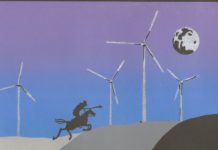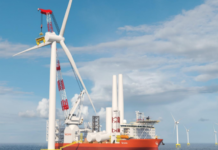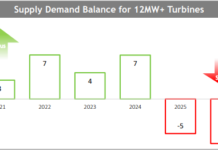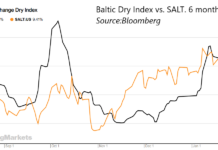Tom Konrad CFA
I published my rebuttal to John Petersen’s recent article “Gone With The Wind – Debunking Geographic Diversity” on November 1st last year. It was titled Alternative Energy: The Paradigm is the Problem.
That article had two parts. The first part focused on electric vehicles, and argued that the problem with the electric car was not electric propulsion, but the car paradigm. I concluded that electric propulsion makes considerably more sense for electric bikes, trains, and buses. John clearly understood that section, because he published an article just last week “Lux Research Confirms that Cheap Will Beat Cool in Vehicle Electrification,” showing how a recent report from Lux Research confirmed my ideas that electric bikes, and heavy vehicles (delivery trucks, buses, and train locomotives) would be the dominant electric vehicles for the next decade.
Trapped in an Invalid Paradigm
The second part of my Paradigm article was headed “Wind and the Grid,” and it appears that John stopped paying attention at this point. He certainly missed the sentence where I said “critiques of wind power’s variability implicitly assume that nothing can be done to make the electric system more accommodating to wind, when in fact there is much that can be done,” as well as the steps I outlined to address the problem.
Let’s dissect how John’s paradigm leads him to invalid conclusions.
John analyzed wind production data from five widely dispersed regions, finding that his model grid produced less than 12.5% of rated capacity 18.5% of the time, less than 6.25% of rated capacity 1.6% of the time.
That sounds pretty bad, doesn’t it? He clearly thought it was bad, because he concluded, “wind power will never be stable or reliable enough to serve the needs of an industrialized society.”
I find this conclusion a little hard to swallow. If he had said “never be stable or reliable enough to serve all the needs of an industrialized society,” I would not have a problem with his statement. But he’s trapped by the paradigm that says the only useful electricity is either always on (baseload) or dispatchable (on-demand.) Even with geographic diversification, wind and solar are neither, but they do serve the highly useful function of allowing us to conserve precious dispatchable resources (hydropower, some biomass, natural gas, energy storage, and demand response) to fill in the gaps when they are not available. This function does not serve all the needs of society, but it does free up valuable resources to serve those needs at other times.
Rated Capacity: The Wrong Yardstick
John’s use of “rated capacity” of wind farms to measure shortfalls in production is also an artifact of the conventional power paradigm that exaggerates the lows in wind power production. With baseload resources such as coal and nuclear, which are often operating at full rated capacity, measuring output in comparison to rated capacity makes a certain sense, although even coal would not stand up to the test that Petersen expects wind to pass. A typical coal plant has a capacity factor of 80% to 90%. About 10% of the time, the coal plant is not operating at all (it may be down for maintenance, coal supplies may be delayed, or there may be some mechanical problem which forced it to shut down.) By Petersen’s apparent logic, if coal plants are not operating at all 10% of the time, they must not be stable or reliable enough to serve the needs of an industrialized society.
This, of course, is bogus. Coal plants are useful, because most of the shutdowns are predictable enough that other resources can be made available to fill the gap in electricity supply. With planning, coal plants can even be shut down during periods when seasonal electricity demand is low, and electricity production from wind is high.
Wind is less predictable than coal, but weather is not random, especially over large regions a few hours in advance. With good weather prediction, the gaps in wind power can also be filled with other resources.
Maximum Production
Returning to “rated capacity,” wind power produces on average between 20% and 40% of rated capacity, while a coal plant’s average production (capacity factor) is between 80% and 90%. Comparing actual production to average production might bias the numbers in favor of wind, just as comparing actual production to rated capacity biases the numbers in favor of coal. A fairer comparison falls in between: comparing actual production to maximum production. For dispatchable and baseload resources, maximum production and rated capacity are the same. For a diversified portfolio of variable resources, maximum capacity is considerably lower than rated capacity.
For the portfolio of four widely dispersed wind turbines I discussed in my article “Why Geographic Diversification Smooths Wind Power” the maximum production was 93% of rated capacity. That was for a portfolio of four widely dispersed turbines.
Petersen collected much better data than my own, so I asked him for a copy of his spreadsheet. He gathered wind production data for five widely dispersed regions, each of which contains hundreds of turbines. Over such a large region and so many turbines, maximum production will be far below the rated capacity of the system. In particular, the maximum production from his 16 GW-rated supergrid was only 7 GW, well below half the rated capacity.
Compared to the maximum output of 7 GW, the electricity production from Petersen’s supergrid looks much more stable.


The two graphs above show distributions of the wind power production during six hour intervals over the two months for which Petersen collected the data. I created them by sorting each month’s worth of intervals by total power production during the interval.
As we can see from the graph, wind power production in January is fairly well behaved. Minimum production was 900 MW, or 13% of the system’s maximum production. July production falls well short of 1 MW for two six hour periods, when it is 468MW and 356MW, or 5% and 7% of maximum production. While these lows in production are not good, comparing them to notional rated capacity (more than twice maximum production) creates the illusion of a much greater shortfall in production than actually exists.
Below, I’ve prepared a histogram of wind output for Petersen’s supergrid. I found the rel
ative consistency of wind output in January 2010 particularly striking, with wind production being between 3 GW and 4 GW over 40% of the time.

Conclusion
Variable resources like wind cannot substitute for dispatchable power, but they can produce valuable energy cheaply when they are available. The less variable the wind power resource is, the less dispatchable power is needed to back it up, and the most economical way to reduce variability is geographic diversification.
To see just how effective geographic diversification can be, compare the above histogram of the wind power output of Petersen’s supergrid with the equivalent histogram below of one of the supergrid’s five components: the wind output from the Bonneville Power Association (BPA) region.

If we want to see large-scale integration of inexpensive wind power, producing no global warming emissions and requiring no water, we’ll also need to greatly enhance our electric grid. Wind power investors should also be transmission investors.
Data & Charts
The spreadsheet I used to create all the charts above is available here as an Open Office spreadsheet and here in Excel.
Past performance is not a guarantee or a reliable indicator of future results. This article contains the current opinions of the author and such opinions are subject to change without notice. This article has been distributed for informational purposes only. Forecasts, estimates, and certain information contained herein should not be considered as investment advice or a recommendation of any particular security, strategy or investment product. Information contained herein has been obtained from sources believed to be reliable, but not guaranteed.








An excellent refutation of Pedersen’s conclusion. I was going to reply to his article, but you’ve done a much better job.
This point is utter nonsense: “wind power will never be stable or reliable enough to serve the needs of an industrialized society.”
For proof, have a look at Spain’s electricity grid:
https://demanda.ree.es/demanda.html
It’s in Spanish, but it’s relatively straight forward. Wind is consistently providing 20% of that country’s electricity supply, and on many days, it is up around 30%. One can also see the diverse mix of sources currently being used.
One point: I think your figures regarding coal’s capacity factors are rather high. According to the EIA, in 2009, U.S. coal plants had an average capacity factor of 63%.
In any case, wind and solar have consistently brushed aside the limits that were estimated for grid penetration. It was said that wind could only provide 20% of a grid’s electricity before problems began. Germany and Spain have patently shown this to be wrong. Spain has had days of 50% electricity from wind. Northern Germany (Niedersachsen, etc.) has experienced the same.
As for solar, Germany can now produce 25% of its peak electricity needs (70 GWp) from solar PV (17 GWp) on sunny afternoons.
I’ve enjoyed John’s posts on battery tech, but his recent posts on wind have him barking up the wrong tree.
I love this give and take! Thanks to you both for enlightening me. Its great things you are doing for your readers and your efforts are appreciated.
-David Lane
Petersen seems to enjoy challenging the consensus. It’s most effective in sectors where he’s an expert. But at least he gathered some useful data.
The problem I see with looking at averages is that it takes focus away from the wholly predictable monthly extremes.
I don’t want to be forced to cease productive activity on wind holidays. I want reliable power 24/7 and wind simply can’t provide it. It may be great 2/3 of the time, but the other 1/3 is a bitch – the ultimate in demand management.
FWIW, the e-bike theme was a response to the Lux report and echoed a theme that I’ve discussed several times. From my perspective your earlier writings on that subject were just preaching to the choir.
John,
I’m not looking at averages. My point is simply that geographic diversification reduces the number and severity of wind holidays, and that allows more wind to economically be used as part of a reliable generation portfolio.
Take a look at the two histograms at the end of the article. IF we consider the bottom bar a “wind holiday” we see that the diversified portfolio is only “on holiday” 1.7% of the time. Meanwhile, wind in the BPA region alone is “on holiday” between 25% and 50% of the time. This is a dramatic difference.
Wind alone does not produce reliable power- you do need some back up from dispatachable sources. That does not mean that wind is useless, and to argue that it must be available 24/7/365 in order to be useful is to attack a straw man.
As I said in the article,
“Even with geographic diversification, wind and solar are neither [baseload nor dispatchable], but they do serve the highly useful function of allowing us to conserve precious dispatchable resources (hydropower, some biomass, natural gas, energy storage, and demand response) to fill in the gaps when they are not available. This function does not serve all the needs of society, but it does free up valuable resources to serve those needs at other times.”
Regarding ebikes, I agree you were writing about that idea before my November article, although I don’t recall you ever mentioning heavy vehicles before then. Not that I’m saying you got the idea from me… my main point was to contrast your understanding of the problems of the EV paradigm with your acceptance of the outdated baseload/dispatchable power paradigm.
I think we’ll have to agree to disagree on the relative merits of wind.
I might agree that wind can conserve natural gas, but hydropower, energy storage?
More importantly, at what costs does wind conserve precious resources? The article suggests at any costs, as every wind park has to be backed up by two or three more parks at a large distance, in an unpopulated area, as people there would have electricity demand themselves. And the supergrid to connect these parks does not come cheap, too.
Of course does a power-duration curve look smoother than the time data, that is what its goal is. But it is hardly useful for anything more than determining the base load.
John Petersen has well shown that the common assumption of geographic balancing should be substantiated. “Consensus” has often shown a very bad argument, so he is very right to challenge it.
A reader took a a deeper look at the data here: http://seekingalpha.com/user/530678/instablog
Jan,
Hydropower is limited by the amount of water in the stream, so of course wind can conserve it, and with energy storage (including pumped hydro,) wind can charge the storage when it’s abundant, and it can be discharged when winds are low.
The main controversy here seems to be that we mean different things… I would not even use the term “geographic balancing” because it implies that wind power alone can somehow match load. It can’t, and no one is claiming that it can, but yet you and Petersen seem set on “debunking” a statement that no one is making.
As for the costs, there is always a trade-off: more local back-up of wind power, or more transmission. Right now, we try to do almost everything locally, which is too expensive… the pendulum needs to swing in the other direction. How far it should go should be subjected to rigorous cost benefit analysis.
John,
I understand I can’t convince you. I find it frustrating because you are impossible to convince because you refuse to understand the argument.
I don’t disagree with your analysis as long as wind, like all things is deployed in moderation and all the elements required to achieve the maximum benefit are deployed concurrently.
Too much wind will prove itself catastrophically unstable unless all the other elements are in place and that instability will rapidly turn public opinion against the solution. We ought to be taking a systems approach to wind and phasing it in only as we have the transmission and standby power to support it. That’s not what’s happening in the real world.
That’s even better because I respect you far too much to disagree with you too intensely.
Agreed. There are many places where continued rapid deployment of wind will not bring the hoped for benefits, and could even lead to grid stability (although in most cases it will just lead to the inefficient use of resources, as we are currently seeing in the BPA region.)
To integrate wind well, we need procedural changes such as larger balancing areas, the integration of weather forecasting into energy supply and usage models, as well as physical changes in the grid, such as more robust long distance transmission infrastructure.
If wind were built out without these improvements and without adequate back-up to meet demand at times of low wind production, it would lead to grid instability.